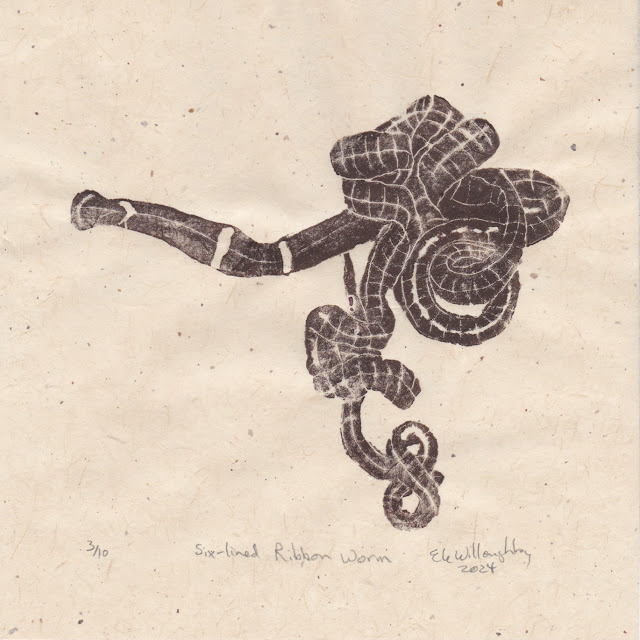April is worm month for #InsertAnInvert2024 and I confess, worms are not my favourite invertebrates. But, I have been making some science art about the worms, especially some flamboyant marine worms. For the prompts long no limbs, long with limbs, not long no limbs and not long no limbs, I made a six-lined ribbon worm, Y, a fuchsia flat worm and an Elvis worm.
 |
| Six-lined Ribbon Worm, linocut, 8" x 8" by Ele Willoughby, 2024 |
The suggested species for the "long, no limbs" theme was Tubalanus sexlineatus. The six-lined ribbon worm (Tubulanus sexlineatus) is dark brown with five narrow, (sometimes discontinuous) longitudinal, white stripes, with indications of a sixth stripe midventrally and encircled in up to 150 white bands. Tubulanus is a genus of primitive nemertean worms in the order Palaeonemertea. It lives on the Pacific coast of North America from Alaska to California. Amazingly this is a species which can to regrow a head after amputation!
What’s inside this cigar box? A black smoker - with giant tube worms (Riftia pachyptila) for #InsertAnInvert2024. I’ve had the idea for this multimedia in my head for years! Cigar box, collaged papers, gouache, Posca pen, glue, washi tape.
I’ve never had the opportunity to go on a research cruise to a
hydrothermal vent, though I have contributed to plans for monitoring and
seen a lot of footage shot by marine geophysicist/geologist/geochemist
colleagues. I used to walk by the top of a chimney daily at work at
PGC; it had been recovered by an ROV (something scientists no longer do,
as these vents are protected).
 |
| Black Smoker multimedia: Cigar box, collaged papers, gouache, Posca pen, glue, washi tape. Ele Willoughby, 2024 |
They are extraordinary, otherworldly environments and it tells us a lot about life that such vents, called black smokers or white smokers (for fluids emitted from the natural chimneys) are home to so many creatures. Crustal fluids in the seabed are vented due to volcanic heating near mid-ocean ridges and chimneys are built with the deposition of minerals in fluids coming out of solution when hot vent fluids (~60°C!) come in contact with the cool ~2°C ocean bottom water. These high pressure environments with hot fluids filled with the sorts of chemicals we find toxic like sulfides, are actually home to vibrant communities based on a food chain founded by chemosynthetic bacteria. These black smokers in the Pacific are often carpeted with these giant tube worms (& home to other invertebrates like limpets, clams, shrimp and more). These extremophiles may also be showing us that hydrothermal vents may have been a nursery for early life on this planet.
The giant tube worms (diameter ~4 cm, length up to 3 m) tolerate extremely high hydrogen sulfide levels and they were a great shock to the geologists who found them in this hostile environment. As adults they make a white chitinous tube, with a bright red branchial plume & NO digestive system but rely on symbiosis with chemosynthetic bacteria for nutrition!
 |
| Black Smoker multimedia: Cigar box, collaged papers, gouache, Posca pen, glue, washi tape. Ele Willoughby, 2024 |
You'll remember I posted this one before: the strange and beautiful fuchsia flatworm (Pseudoceros ferrugineus) with its gorgeous aposematic colours, a warning to predators that it's not worth the trouble to try and eat. A flexible ruffled oval creature it is a little hard to capture in an illustration. It crawls around eating on the reefs of the Indo-Pacific without any fear of predators.
 |
| Elvis worm, linocut on washi, 8" x 8" by Ele Willoughby, 2024 |
In 2020, scientists discovered 4 types of scale worms, with shimmering lavender, blue, orange and exoskeletons, which looked like they were wearing sequined jumpsuits like Elvis Presley! They named these worms Elvis worms. These species in the genus the genus Peinaleopolynoe are called P. goffrediae, P. mineoi, P. orphanae, and P. elvisi. The worm in my print is Peinaleopolynoe orphanae, a iridescent and lavender worm named for geobiologist Victoria Orphan. These fancy scale worms live in the nutrient-rich deep sea. P. orphanae have been observed biting and fighting each other. No matter how pretty, they are actually fierce little creatures in their sequined outfits.
To recreate these iconic worms in print form, I have used layers of delicate handmade Japanese washi paper and iridescent cellophane. It's a challenging thing to photograph or scan but the colours change with the angle of the light.









